SEO
How To Create B2B Google Ad Campaigns That Convert
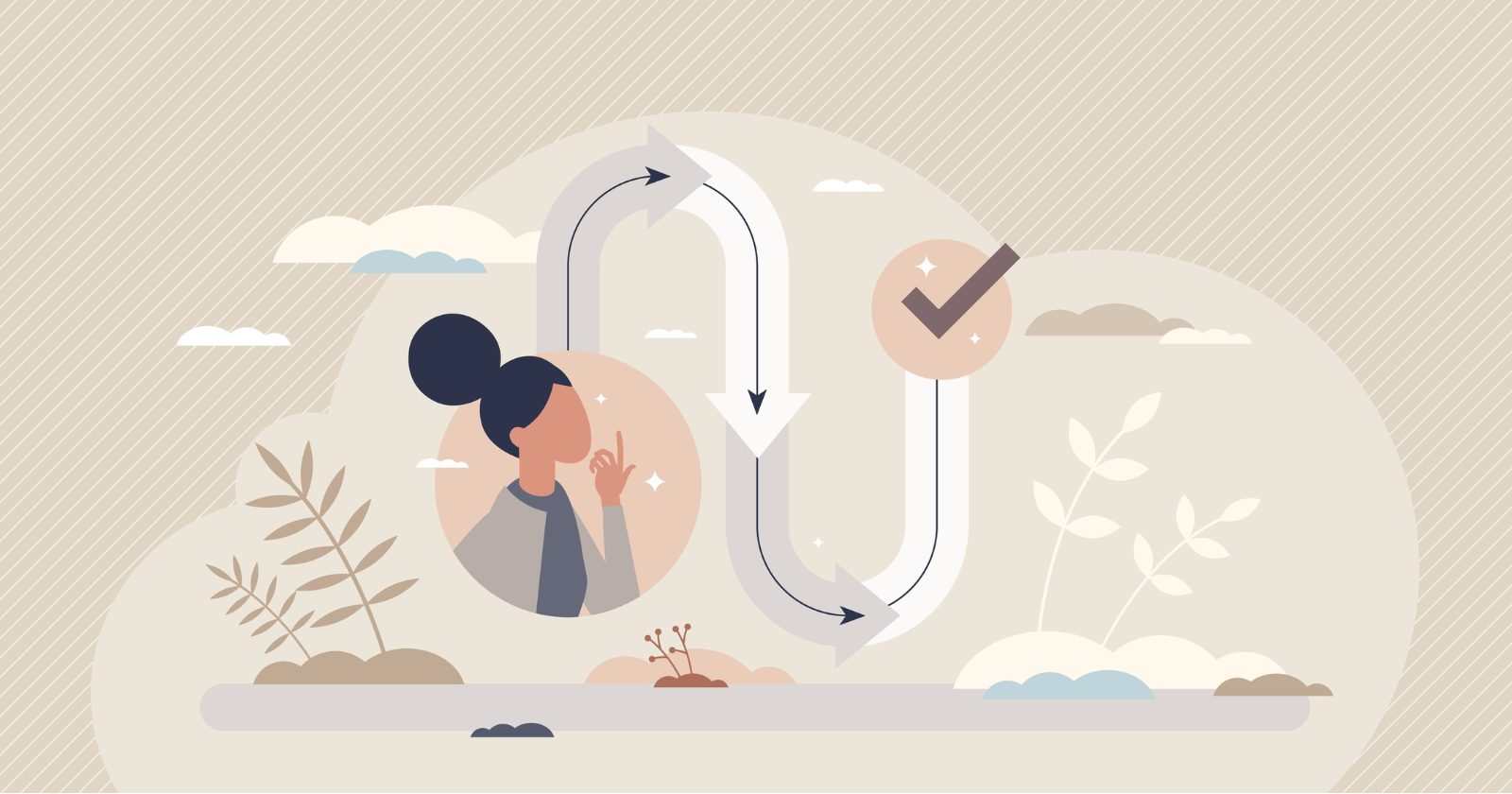
In a world of multi-channel marketing for B2B, narrowing down a specific space where your leads are generated takes time.
Many B2B marketers turn to Google Ads because it has the potential for a quick return on investment (ROI).
But for that scenario to happen, you’ve got to have the right strategy and tactics in place.
Lucky for you, this article will take you from, “I don’t know where to focus my time & budget,” to “I’m managing my Google Ads budget & collecting B2B leads like a boss.”
In fact, Google Ads is among the top most effective paid channels because you can understand the level of “purchase intent” based on the type of keyword used.
So, when you target keywords across multiple intent stages within the sales funnel, creating B2B Google Ads campaigns enables you to efficiently nurture leads toward conversion.
With this in mind, mastering the art of B2B Google Ads campaigns can skyrocket your company’s growth and help you develop a bulletproof, long-term marketing strategy.
So, if you’ve been pondering the question:
“Do Google Ads work for B2B and how can I get the most bang for my buck?”
This article will answer this and set you up for sustainable future success.
Why Use Google Ads Campaigns For Your B2B Lead Generation Efforts
Many ask, “Why should I pay when I can generate leads for free?”
Great question.
First off, let’s start with the fact that no leads come for free. No matter whether you do SEO, social media marketing, or paid advertising, there’s no such thing as free lunch.
All marketing channels have their pros and cons, but Google Ads, in particular, are useful because they:
- Give you the power to control your growth pace based on ad spend and campaigns used.
- Are often quicker to launch because you can start with one landing page.
- Enable you to drive traffic to content based on “high purchase intent” keywords, i.e., search phrases that describe the product or service you’re selling.
In fact, the average B2B Google Ads campaign conversion rate is 3.75%, so if you target high purchase intent keywords, you’ll generate high-quality leads that have a strong chance of becoming customers.
Ready to jump on the Google Ads bandwagon successfully?
Let’s go over how to run a B2B Google Ads campaign based on purchase intent stages within the sales funnel.
How To Run Successful B2B Google Ads Campaigns Based On Sales Funnel Stages
A sales funnel typically consists of three main categories:
- The top of the funnel (TOFU): People who are in an awareness stage in their buying cycle, meaning they’re just becoming aware they have a problem and need to find a solution.
- The middle of the funnel (MOFU): People who are interested or considering buying, and are making comparisons and researching further about the best solution for their specific needs.
- The bottom of the funnel (BOFU): People who are nearly ready to make a purchase and have decided to initiate contact with companies who might be able to help them.
The idea is to craft your B2B Google Ads campaign based on each specific category, using keywords that relate to those corresponding categories.
By doing this, you’ll be able to craft better copy geared towards audiences at the “top of the funnel” compared to those at the “bottom of the funnel,” which will help your campaigns to convert better.
Now that you’ve got the idea, let’s dive into some concrete keyword and campaign examples per funnel stage.
Top Of Funnel
In the TOFU stage, some keywords that might be relevant here are:
- “what is x.”
- “x definition” – because they’re just trying to understand the basics of a certain concept.
Because your audience is ready to soak up all the information, informational long-form content is especially important for them.
Your audience might be aware your brand exists, but not aware of everything you have to offer. They’re a beginner when it comes to the solution you provide, so there shouldn’t be any pushy sales copy here.
Your audience is just warming up to you and they don’t want to be spammed.
When it comes to your bid strategy, you have two options:
- Option 1: Use ECPC (enhanced CPC), which is not entirely automated bidding, but it does allow you to have more control over your budget.
- Option 2: Targeting impression share works well if your objective is brand awareness and reach because you can set a percentage for your impression share against other bidders.
For your retargeting strategy, it’s a good idea to set up an audience on Google to collect visitor information to the page you send users.
Depending on the traffic amount (1,000 or more visitors are needed before you can retarget), we can use this audience for retargeting our MOFU campaign.
You also need to set the goal type.
Your first campaign should not be a hard sell, as here, you need to focus on generating demand for your product or service.
Naturally, there may be an influx of new users (but hardly any conversions), so you’ll want to ensure your campaign objective offers a high-value and low-friction micro conversion, such as getting someone to read an informational content piece.
Depending on the volume of users, you should look at setting up a micro-conversion for page engagement.
Below is an example of a TOFU B2B Google Ads campaign in action targeting the keyword “what is an ai chatbot.”

The ad introduces the brand and answers the keyword in question. Clicking through to the landing page, we’re not introduced to a hard sell, but instead are given a “complimentary guide” to learn more about this specific AI Chatbot.
There is no mention of pricing, or the specific product here. It matches the user search intent by providing the user with exactly what they requested.
The bonus is it also allows the business to collect email addresses, which can then be sent email nurturing campaigns later on.
Middle Of Funnel
Your MOFU audience members are those who know your product or service exists and have done some research on potential solutions.
They might even already be considering you as an option, but need to know exactly how you can help, and why you’re a better choice than your competitors. Their decision is also likely heavily influenced by third-party opinions of your brand.
In this case, your Google Ads campaign could promote the following:
- Technical “how-to guides.”
- Product comparison.
Your audience likely has a foundational understanding of the topic or industry, but they’re still looking to improve their knowledge and identify the best solution for them.
Cue offer messaging here! Your people are getting ready for an information-based soft sell.
For your bid strategy, it would be a good idea to use the following:
Unlike ECPC, Maximize Clicks is an automated bidding strategy where Google sets the bids for you, to get the most conversions for your campaign while spending your daily budget.
Once you’re ready to retarget, here’s a possible approach:
Take a look at your previous audience setup for users clicking through from your TOFU campaign and your general website visitors. It’s worthwhile to add this audience as an observation on this campaign.
 Screenshot by author, December 2022
Screenshot by author, December 2022
You can increase bids for users who have already interacted with your brand, which ensures your ads are in a higher position and keeps brand awareness at the forefront.
Again, using audiences from this page and adding bid targeting to your BOFU campaign is a good idea.
For your MOFU goal type, you’ll need to offer more information to help your audience decide – but at this stage, you’ll want to get into the nitty-gritty details.
Although users might be somewhat unaware of your brand, they have a good sense of the product or service they want, as they are now fully in their research phase to find the most suitable product or service to fulfill their needs.
The goal here can be offering downloadable guides and product comparisons while also still using micro-conversions, such as tracking a conversion for every download.
To give you a better idea, let’s take a quick look at a MOFU B2B Google Ads campaign example targeting the keyword “how to set up an ai chatbot.”
 Screenshot of search for [how to build a chatbot], Google, December 2022
Screenshot of search for [how to build a chatbot], Google, December 2022
With this ad example, the user has likely done enough research to start looking at ways to install a chatbot, which the ad answers exactly that question with the ad copy.
Furthermore, we can see that, similar to TOFU, there isn’t a hard sell on this page, as the user intent isn’t yet to purchase their product. Instead, they have offered a free ebook in exchange for contact details.
Bottom Of Funnel
BOFU is where the magic happens: lead generation conversions. Your audience is ready to buy and needs one more push to click that purchase, book a demo, or contact us button.
Relevant keywords here might be:
- x service.
- x tool.
- x platform.
At this stage, you’ll want to whip out your conversion-based landing pages and ask for the sale because:
- Your audience here is strongly aware of your brand.
- They’re considering making a purchase and have a decent understanding of your solution.
For your bid strategy, consider using Maximize Conversions, as users are nearly at the end of their decision-making and are more inclined to get in touch with you.
When you’re ready to retarget, enable retargeting for all users who visit this page but don’t convert. You can also retarget users using display campaigns on Google or other similar platforms, such as AdRoll.
It would be worth considering setting up retargeting on other platforms, such as LinkedIn and Facebook, too.
Because this campaign has the highest intent for the users in the purchase cycle, a high-converting landing page is recommended here that offers all of the above information and more.
This is your chance to offer lead forms and get in touch with forms that include calls to action (CTAs) at the top and at easily accessible points throughout the page.
To give an example, check out this Bofu B2B Google Ads campaign for the keyword “ai chatbot for customer service.”
 Screenshot of search for [ai chatbot for customer service], Google, December 2022
Screenshot of search for [ai chatbot for customer service], Google, December 2022
From the above BOFU keyword, we can now be sure the user knows exactly what they need – it’s now just picking the perfect solution for them.
By understanding the specific use case, the ads have been tailored for each scenario, increasing CTR. It also lists relevant site link assets (AKA extensions) that the user will also find useful, such as pricing and demo.
Secondly, the landing page used here is a high conversion page in that it offers relevant CTA’s throughout the page, uses trust-building messages, contact CTAs, and, more importantly, it highlights the product’s value.
Implement The Right Google Ads Strategy To Generate High-Quality B2B Leads
Overall, Google Ads is incredibly effective for B2B businesses because it’s a great starting point for long-term growth.
Not only can you retarget across other channels, but you also have the ability to target keywords based on level purchase intent within the sales funnel.
Now that you’re a pro at B2B Google Ads campaigns, you’ll be able to spend smart and optimize effectively!
More research:
Featured Image: VectorMine/Shutterstock
var s_trigger_pixel_load = false;
function s_trigger_pixel(){
if( !s_trigger_pixel_load ){
striggerEvent( ‘load2’ );
console.log(‘s_trigger_pix’);
}
s_trigger_pixel_load = true;
}
window.addEventListener( ‘cmpready’, s_trigger_pixel, false);
window.addEventListener( ‘load2’, function() {
if( sopp != ‘yes’ && !ss_u ){
!function(f,b,e,v,n,t,s)
{if(f.fbq)return;n=f.fbq=function(){n.callMethod?
n.callMethod.apply(n,arguments):n.queue.push(arguments)};
if(!f._fbq)f._fbq=n;n.push=n;n.loaded=!0;n.version=’2.0′;
n.queue=[];t=b.createElement(e);t.async=!0;
t.src=v;s=b.getElementsByTagName(e)[0];
s.parentNode.insertBefore(t,s)}(window,document,’script’,
‘https://connect.facebook.net/en_US/fbevents.js’);
if( typeof sopp !== “undefined” && sopp === ‘yes’ ){
fbq(‘dataProcessingOptions’, [‘LDU’], 1, 1000);
}else{
fbq(‘dataProcessingOptions’, []);
}
fbq(‘init’, ‘1321385257908563’);
fbq(‘track’, ‘PageView’);
fbq(‘trackSingle’, ‘1321385257908563’, ‘ViewContent’, {
content_name: ‘b2b-google-ad-campaigns’,
content_category: ‘pay-per-click’
});
}
});
SEO
How To Write ChatGPT Prompts To Get The Best Results

ChatGPT is a game changer in the field of SEO. This powerful language model can generate human-like content, making it an invaluable tool for SEO professionals.
However, the prompts you provide largely determine the quality of the output.
To unlock the full potential of ChatGPT and create content that resonates with your audience and search engines, writing effective prompts is crucial.
In this comprehensive guide, we’ll explore the art of writing prompts for ChatGPT, covering everything from basic techniques to advanced strategies for layering prompts and generating high-quality, SEO-friendly content.
Writing Prompts For ChatGPT
What Is A ChatGPT Prompt?
A ChatGPT prompt is an instruction or discussion topic a user provides for the ChatGPT AI model to respond to.
The prompt can be a question, statement, or any other stimulus to spark creativity, reflection, or engagement.
Users can use the prompt to generate ideas, share their thoughts, or start a conversation.
ChatGPT prompts are designed to be open-ended and can be customized based on the user’s preferences and interests.
How To Write Prompts For ChatGPT
Start by giving ChatGPT a writing prompt, such as, “Write a short story about a person who discovers they have a superpower.”
ChatGPT will then generate a response based on your prompt. Depending on the prompt’s complexity and the level of detail you requested, the answer may be a few sentences or several paragraphs long.
Use the ChatGPT-generated response as a starting point for your writing. You can take the ideas and concepts presented in the answer and expand upon them, adding your own unique spin to the story.
If you want to generate additional ideas, try asking ChatGPT follow-up questions related to your original prompt.
For example, you could ask, “What challenges might the person face in exploring their newfound superpower?” Or, “How might the person’s relationships with others be affected by their superpower?”
Remember that ChatGPT’s answers are generated by artificial intelligence and may not always be perfect or exactly what you want.
However, they can still be a great source of inspiration and help you start writing.
Must-Have GPTs Assistant
I recommend installing the WebBrowser Assistant created by the OpenAI Team. This tool allows you to add relevant Bing results to your ChatGPT prompts.
This assistant adds the first web results to your ChatGPT prompts for more accurate and up-to-date conversations.
It is very easy to install in only two clicks. (Click on Start Chat.)
For example, if I ask, “Who is Vincent Terrasi?,” ChatGPT has no answer.
With WebBrower Assistant, the assistant creates a new prompt with the first Bing results, and now ChatGPT knows who Vincent Terrasi is.
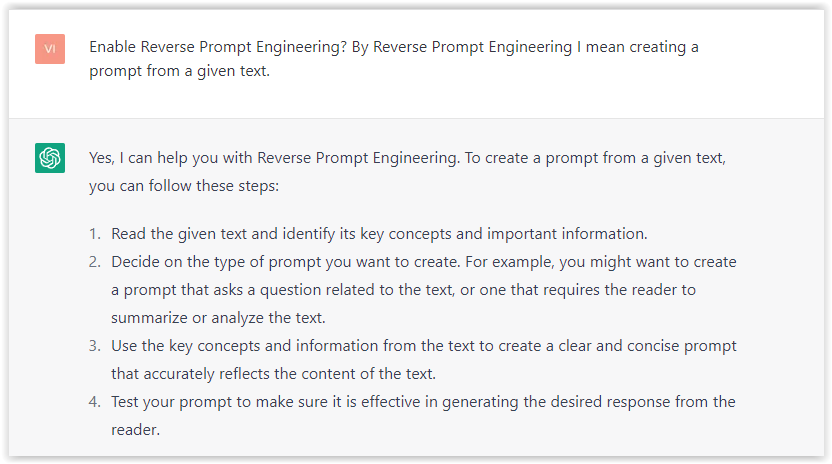 Screenshot from ChatGPT, March 2023
Screenshot from ChatGPT, March 2023You can test other GPT assistants available in the GPTs search engine if you want to use Google results.
Master Reverse Prompt Engineering
ChatGPT can be an excellent tool for reverse engineering prompts because it generates natural and engaging responses to any given input.
By analyzing the prompts generated by ChatGPT, it is possible to gain insight into the model’s underlying thought processes and decision-making strategies.
One key benefit of using ChatGPT to reverse engineer prompts is that the model is highly transparent in its decision-making.
This means that the reasoning and logic behind each response can be traced, making it easier to understand how the model arrives at its conclusions.
Once you’ve done this a few times for different types of content, you’ll gain insight into crafting more effective prompts.
Prepare Your ChatGPT For Generating Prompts
First, activate the reverse prompt engineering.
- Type the following prompt: “Enable Reverse Prompt Engineering? By Reverse Prompt Engineering I mean creating a prompt from a given text.”
 Screenshot from ChatGPT, March 2023
Screenshot from ChatGPT, March 2023ChatGPT is now ready to generate your prompt. You can test the product description in a new chatbot session and evaluate the generated prompt.
- Type: “Create a very technical reverse prompt engineering template for a product description about iPhone 11.”
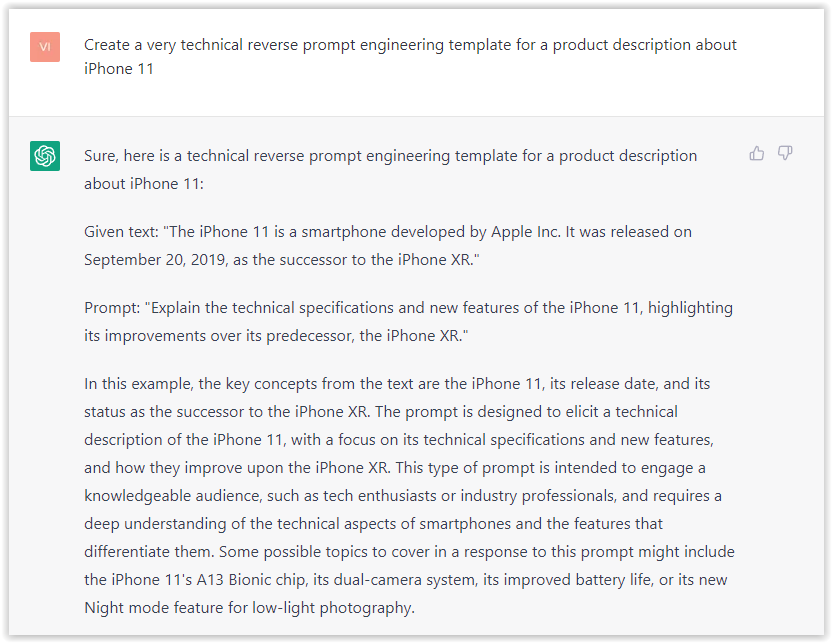 Screenshot from ChatGPT, March 2023
Screenshot from ChatGPT, March 2023The result is amazing. You can test with a full text that you want to reproduce. Here is an example of a prompt for selling a Kindle on Amazon.
- Type: “Reverse Prompt engineer the following {product), capture the writing style and the length of the text :
product =”
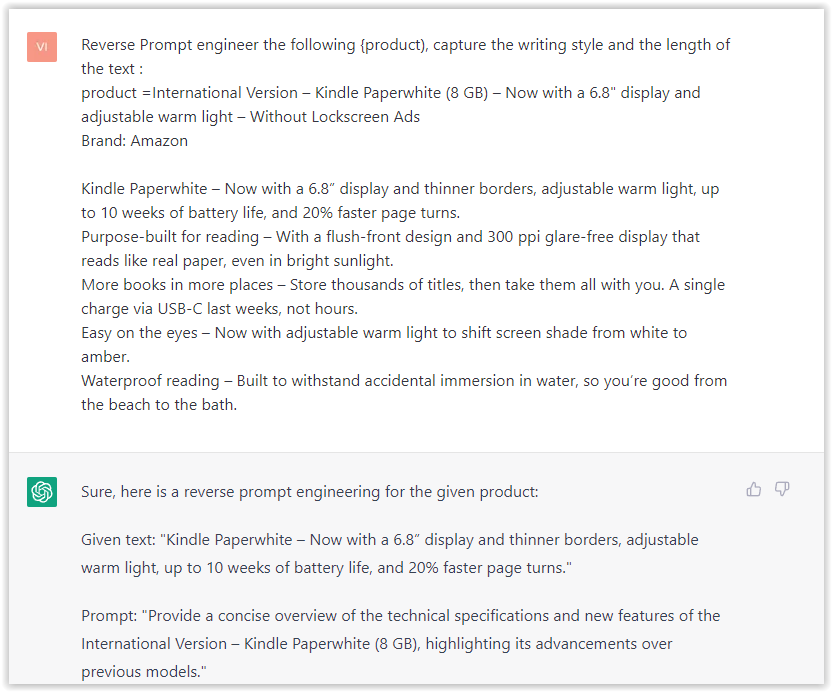 Screenshot from ChatGPT, March 2023
Screenshot from ChatGPT, March 2023I tested it on an SEJ blog post. Enjoy the analysis – it is excellent.
- Type: “Reverse Prompt engineer the following {text}, capture the tone and writing style of the {text} to include in the prompt :
text = all text coming from https://www.searchenginejournal.com/google-bard-training-data/478941/”
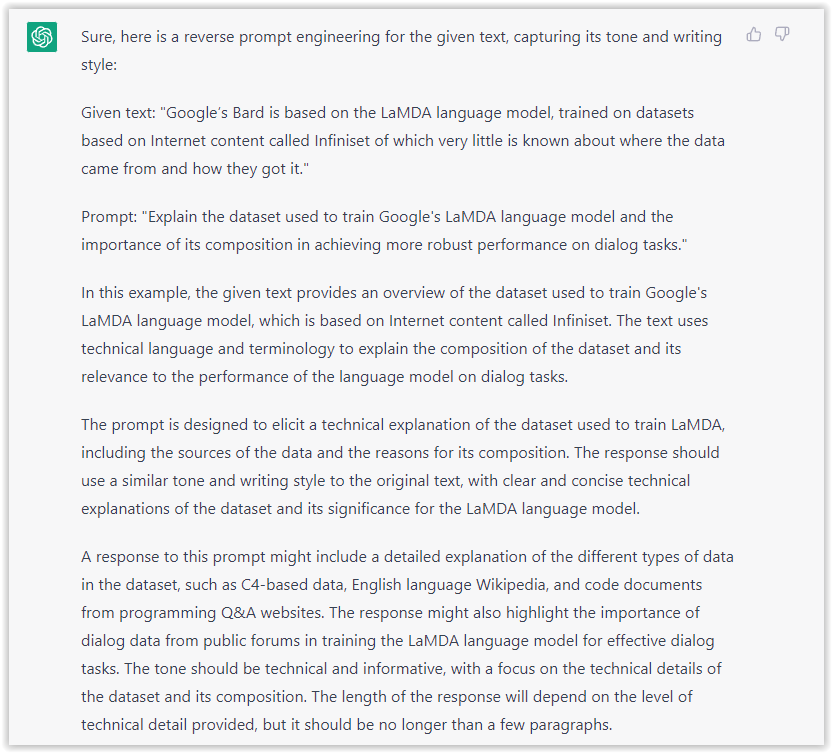 Screenshot from ChatGPT, March 2023
Screenshot from ChatGPT, March 2023But be careful not to use ChatGPT to generate your texts. It is just a personal assistant.
Go Deeper
Prompts and examples for SEO:
- Keyword research and content ideas prompt: “Provide a list of 20 long-tail keyword ideas related to ‘local SEO strategies’ along with brief content topic descriptions for each keyword.”
- Optimizing content for featured snippets prompt: “Write a 40-50 word paragraph optimized for the query ‘what is the featured snippet in Google search’ that could potentially earn the featured snippet.”
- Creating meta descriptions prompt: “Draft a compelling meta description for the following blog post title: ’10 Technical SEO Factors You Can’t Ignore in 2024′.”
Important Considerations:
- Always Fact-Check: While ChatGPT can be a helpful tool, it’s crucial to remember that it may generate inaccurate or fabricated information. Always verify any facts, statistics, or quotes generated by ChatGPT before incorporating them into your content.
- Maintain Control and Creativity: Use ChatGPT as a tool to assist your writing, not replace it. Don’t rely on it to do your thinking or create content from scratch. Your unique perspective and creativity are essential for producing high-quality, engaging content.
- Iteration is Key: Refine and revise the outputs generated by ChatGPT to ensure they align with your voice, style, and intended message.
Additional Prompts for Rewording and SEO:
– Rewrite this sentence to be more concise and impactful.
– Suggest alternative phrasing for this section to improve clarity.
– Identify opportunities to incorporate relevant internal and external links.
– Analyze the keyword density and suggest improvements for better SEO.
Remember, while ChatGPT can be a valuable tool, it’s essential to use it responsibly and maintain control over your content creation process.
Experiment And Refine Your Prompting Techniques
Writing effective prompts for ChatGPT is an essential skill for any SEO professional who wants to harness the power of AI-generated content.
Hopefully, the insights and examples shared in this article can inspire you and help guide you to crafting stronger prompts that yield high-quality content.
Remember to experiment with layering prompts, iterating on the output, and continually refining your prompting techniques.
This will help you stay ahead of the curve in the ever-changing world of SEO.
More resources:
Featured Image: Tapati Rinchumrus/Shutterstock
SEO
Measuring Content Impact Across The Customer Journey
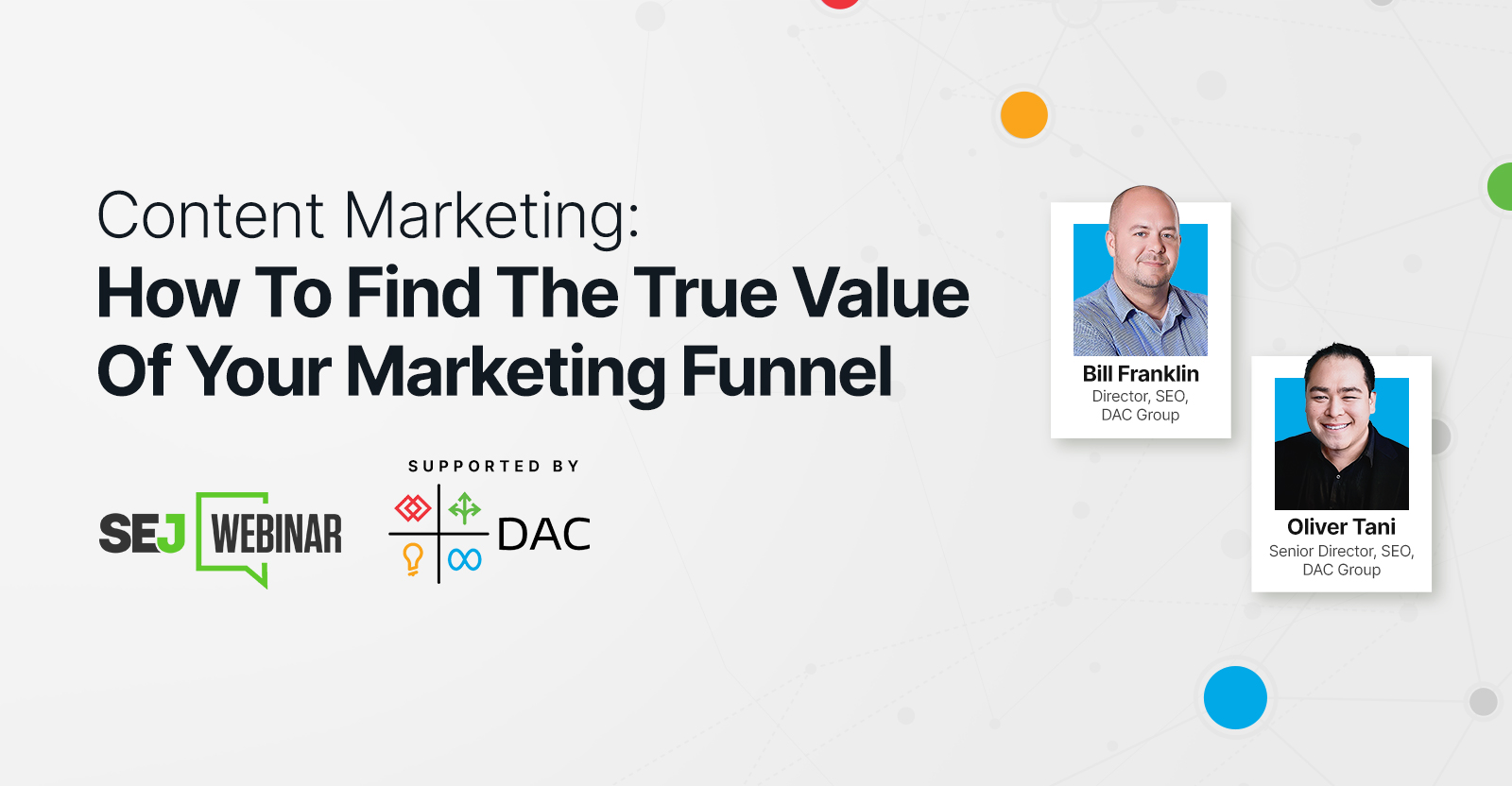
Understanding the impact of your content at every touchpoint of the customer journey is essential – but that’s easier said than done. From attracting potential leads to nurturing them into loyal customers, there are many touchpoints to look into.
So how do you identify and take advantage of these opportunities for growth?
Watch this on-demand webinar and learn a comprehensive approach for measuring the value of your content initiatives, so you can optimize resource allocation for maximum impact.
You’ll learn:
- Fresh methods for measuring your content’s impact.
- Fascinating insights using first-touch attribution, and how it differs from the usual last-touch perspective.
- Ways to persuade decision-makers to invest in more content by showcasing its value convincingly.
With Bill Franklin and Oliver Tani of DAC Group, we unravel the nuances of attribution modeling, emphasizing the significance of layering first-touch and last-touch attribution within your measurement strategy.
Check out these insights to help you craft compelling content tailored to each stage, using an approach rooted in first-hand experience to ensure your content resonates.
Whether you’re a seasoned marketer or new to content measurement, this webinar promises valuable insights and actionable tactics to elevate your SEO game and optimize your content initiatives for success.
View the slides below or check out the full webinar for all the details.
SEO
How to Find and Use Competitor Keywords
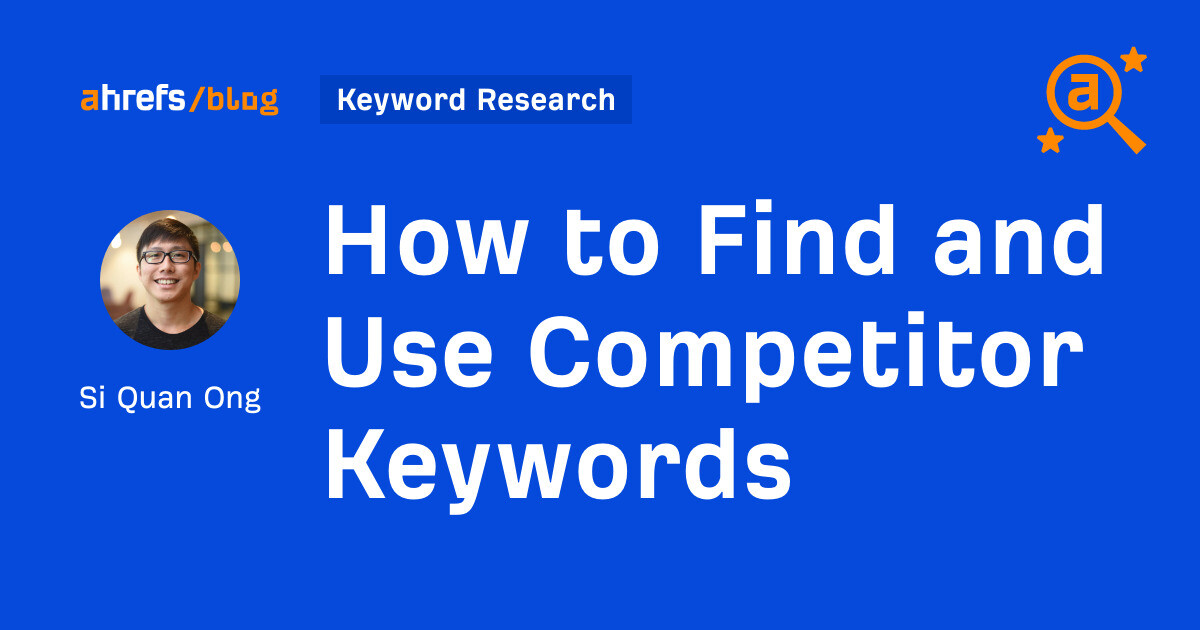
Competitor keywords are the keywords your rivals rank for in Google’s search results. They may rank organically or pay for Google Ads to rank in the paid results.
Knowing your competitors’ keywords is the easiest form of keyword research. If your competitors rank for or target particular keywords, it might be worth it for you to target them, too.
There is no way to see your competitors’ keywords without a tool like Ahrefs, which has a database of keywords and the sites that rank for them. As far as we know, Ahrefs has the biggest database of these keywords.
How to find all the keywords your competitor ranks for
- Go to Ahrefs’ Site Explorer
- Enter your competitor’s domain
- Go to the Organic keywords report
The report is sorted by traffic to show you the keywords sending your competitor the most visits. For example, Mailchimp gets most of its organic traffic from the keyword “mailchimp.”


Since you’re unlikely to rank for your competitor’s brand, you might want to exclude branded keywords from the report. You can do this by adding a Keyword > Doesn’t contain filter. In this example, we’ll filter out keywords containing “mailchimp” or any potential misspellings:
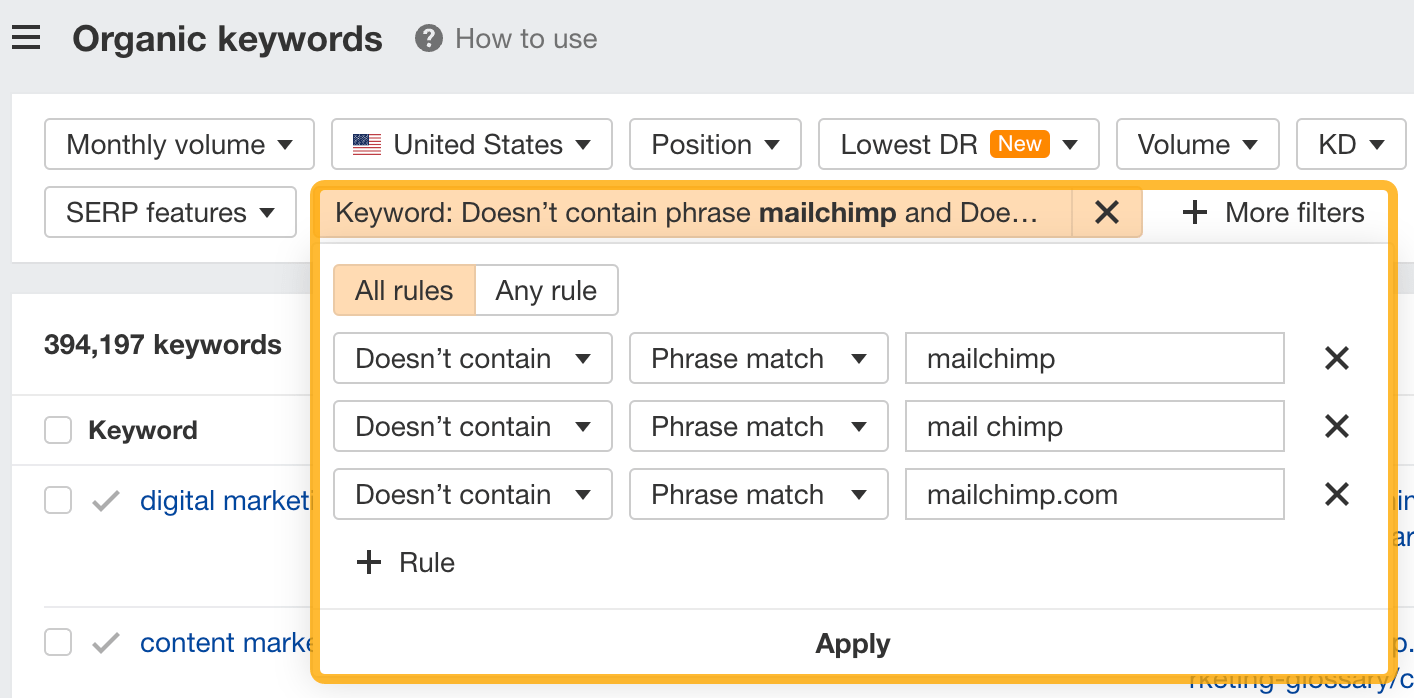

If you’re a new brand competing with one that’s established, you might also want to look for popular low-difficulty keywords. You can do this by setting the Volume filter to a minimum of 500 and the KD filter to a maximum of 10.
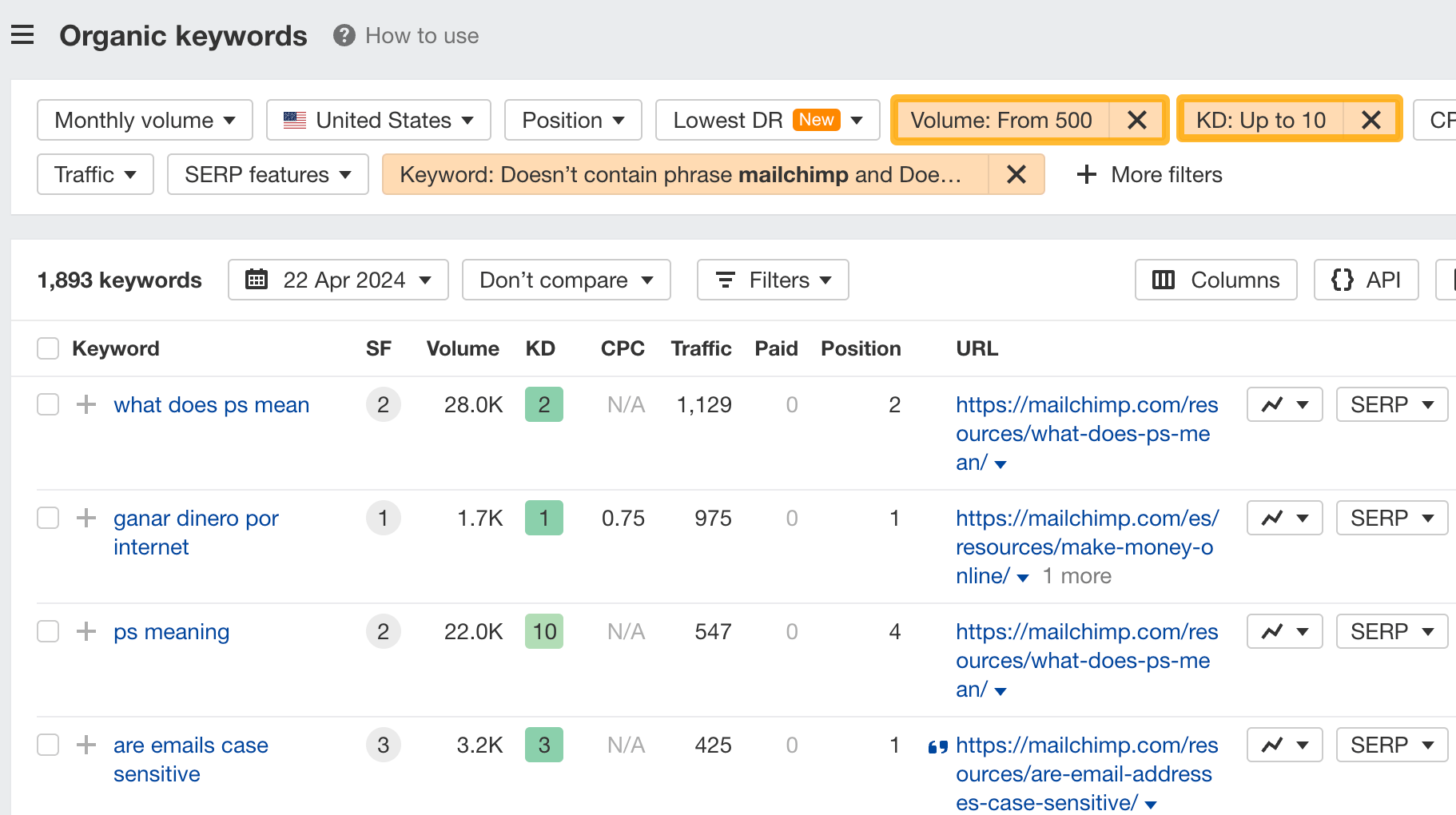

How to find keywords your competitor ranks for, but you don’t
- Go to Competitive Analysis
- Enter your domain in the This target doesn’t rank for section
- Enter your competitor’s domain in the But these competitors do section
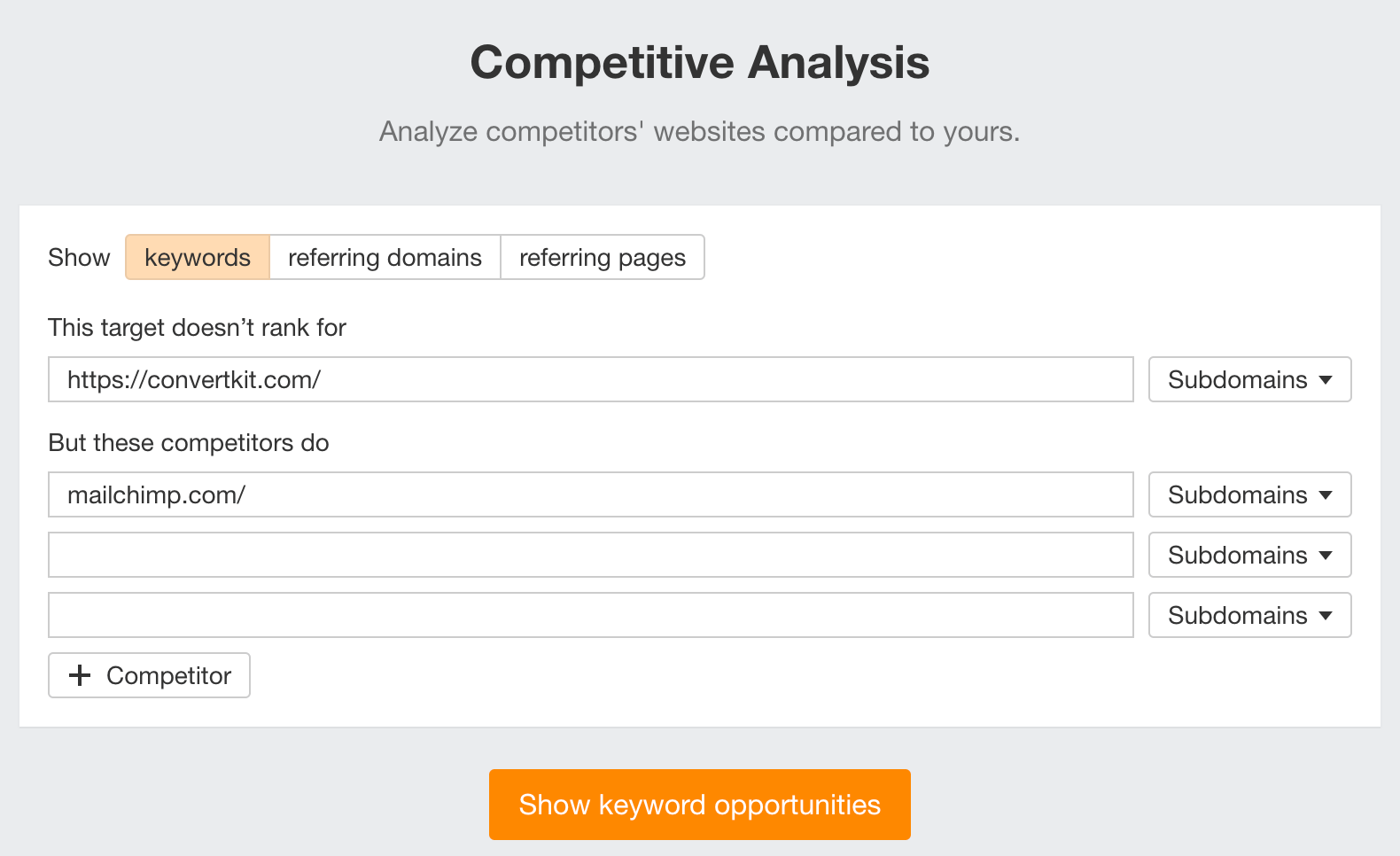

Hit “Show keyword opportunities,” and you’ll see all the keywords your competitor ranks for, but you don’t.
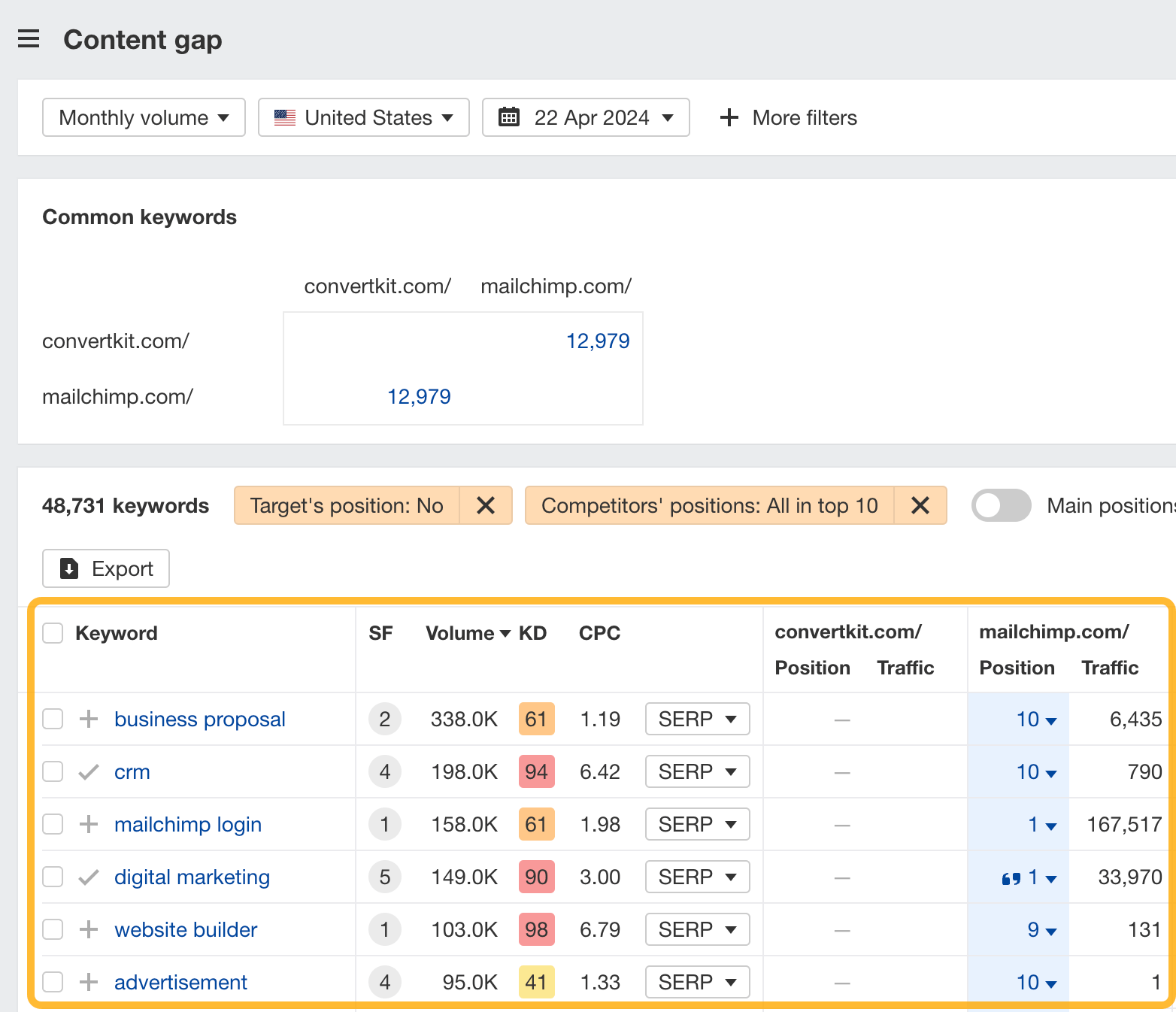

You can also add a Volume and KD filter to find popular, low-difficulty keywords in this report.
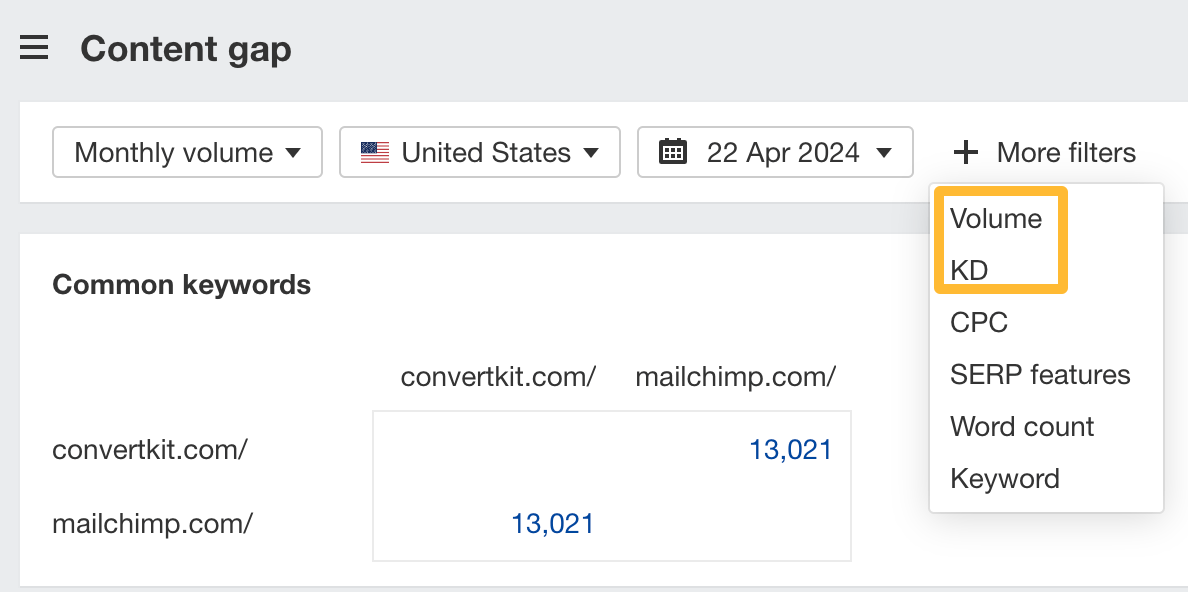

How to find keywords multiple competitors rank for, but you don’t
- Go to Competitive Analysis
- Enter your domain in the This target doesn’t rank for section
- Enter the domains of multiple competitors in the But these competitors do section
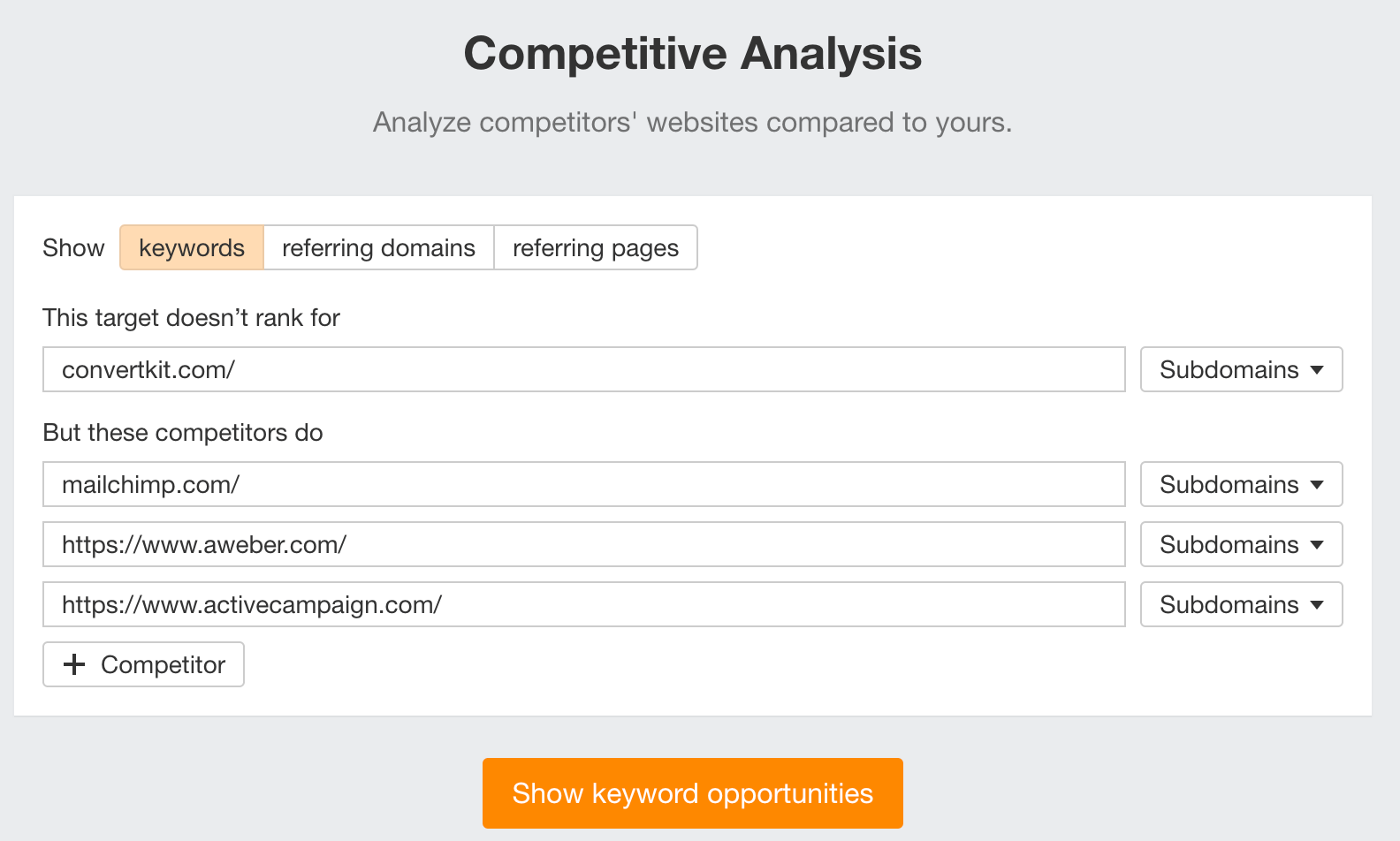

You’ll see all the keywords that at least one of these competitors ranks for, but you don’t.
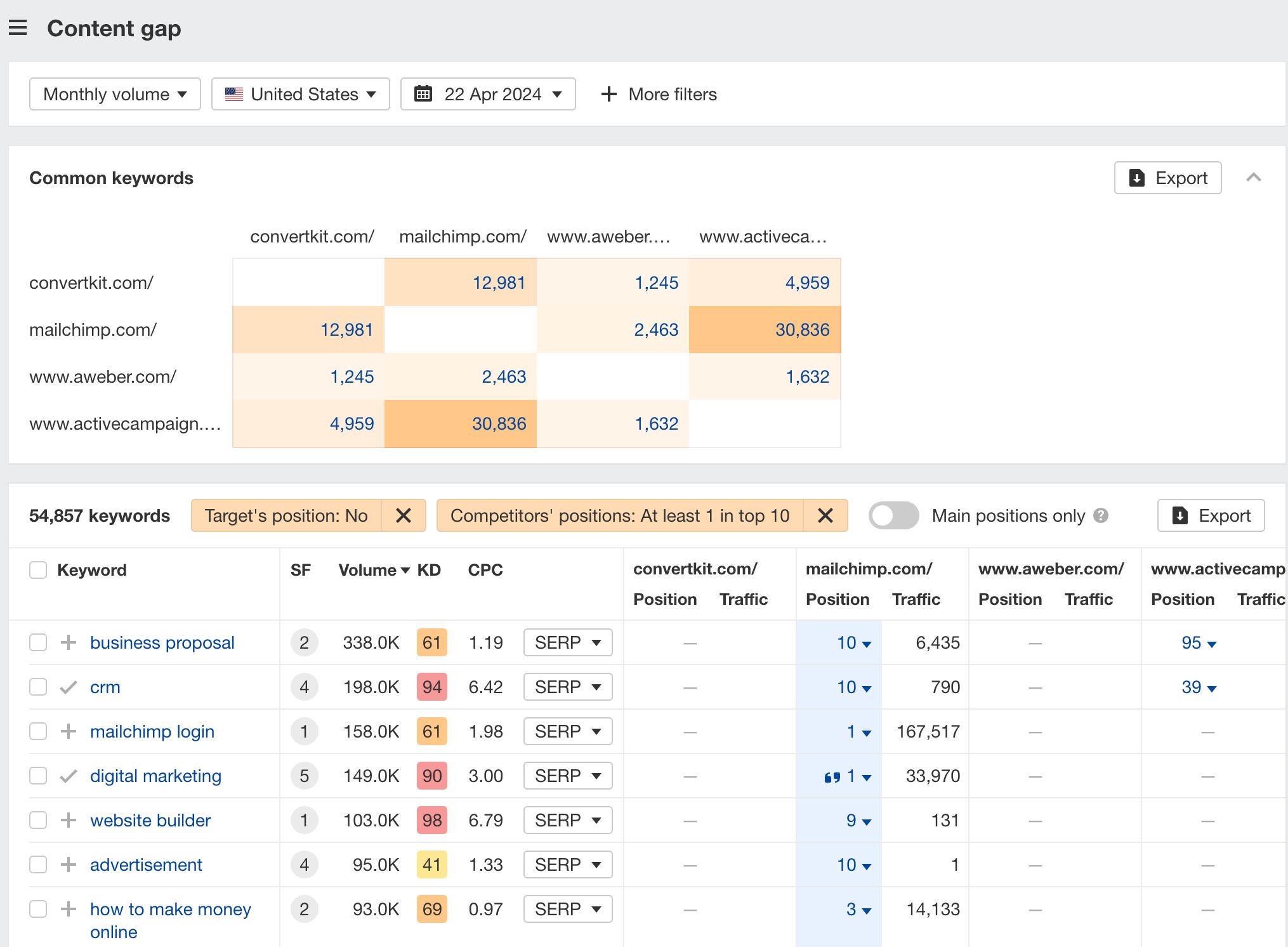

You can also narrow the list down to keywords that all competitors rank for. Click on the Competitors’ positions filter and choose All 3 competitors:
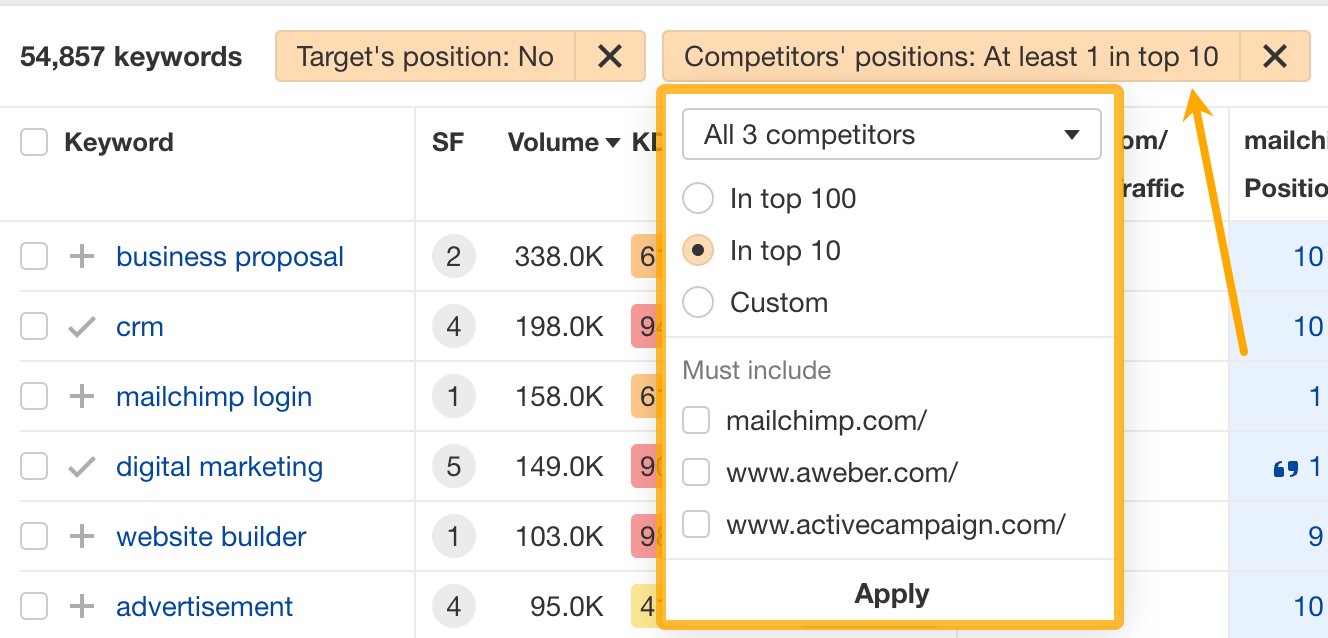

- Go to Ahrefs’ Site Explorer
- Enter your competitor’s domain
- Go to the Paid keywords report
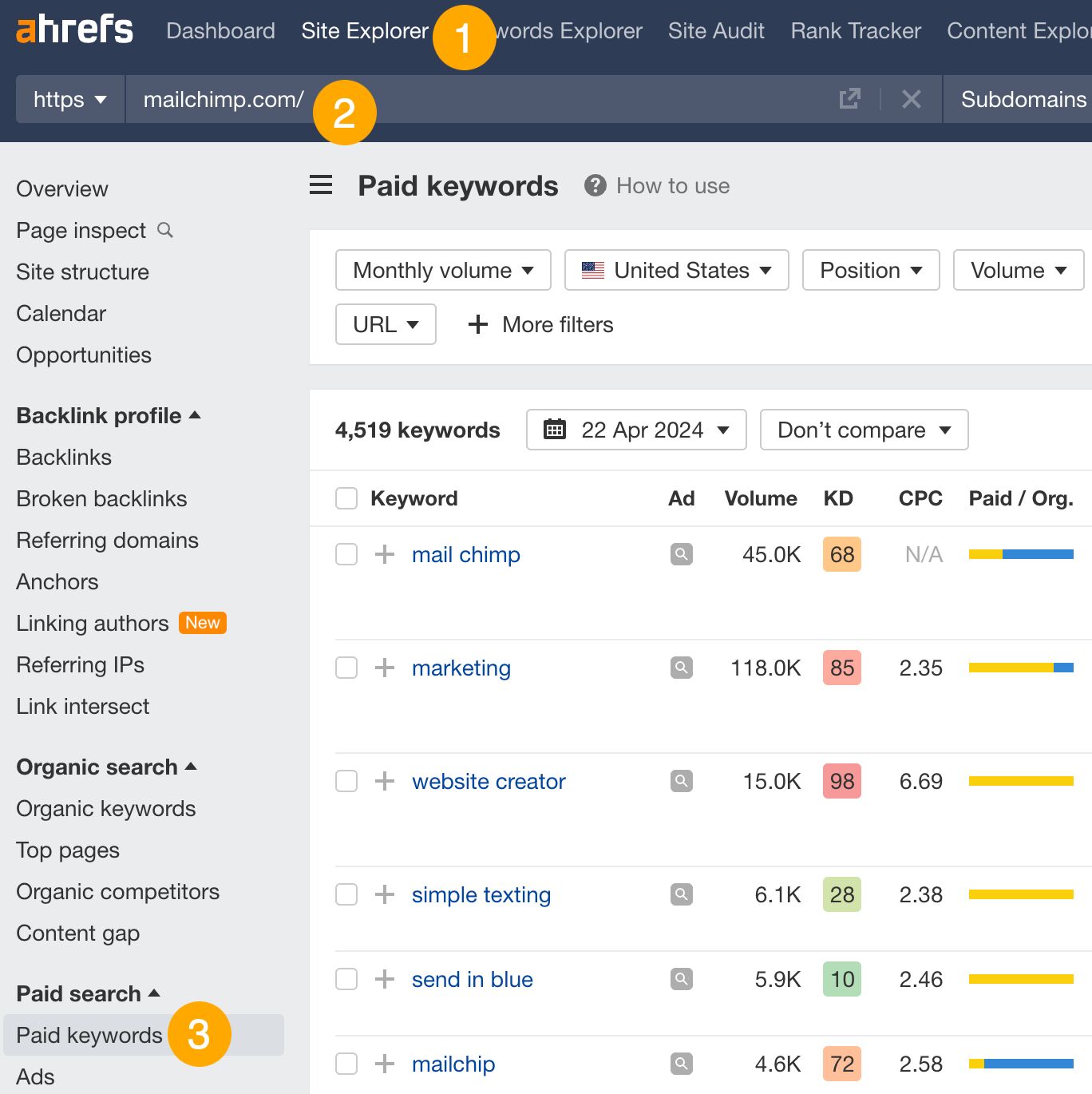

This report shows you the keywords your competitors are targeting via Google Ads.
Since your competitor is paying for traffic from these keywords, it may indicate that they’re profitable for them—and could be for you, too.
You know what keywords your competitors are ranking for or bidding on. But what do you do with them? There are basically three options.
1. Create pages to target these keywords
You can only rank for keywords if you have content about them. So, the most straightforward thing you can do for competitors’ keywords you want to rank for is to create pages to target them.
However, before you do this, it’s worth clustering your competitor’s keywords by Parent Topic. This will group keywords that mean the same or similar things so you can target them all with one page.
Here’s how to do that:
- Export your competitor’s keywords, either from the Organic Keywords or Content Gap report
- Paste them into Keywords Explorer
- Click the “Clusters by Parent Topic” tab
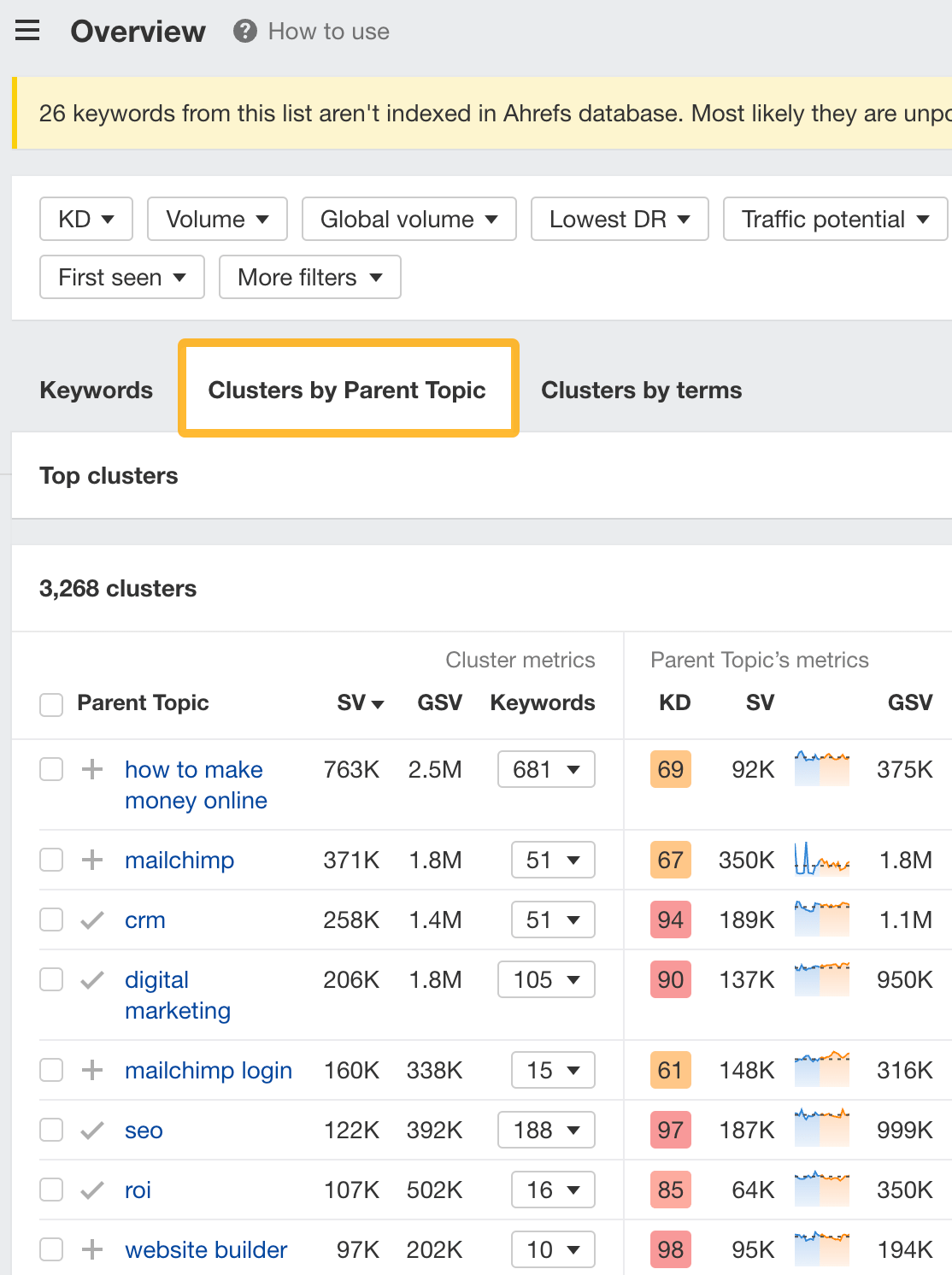

For example, MailChimp ranks for keywords like “what is digital marketing” and “digital marketing definition.” These and many others get clustered under the Parent Topic of “digital marketing” because people searching for them are all looking for the same thing: a definition of digital marketing. You only need to create one page to potentially rank for all these keywords.
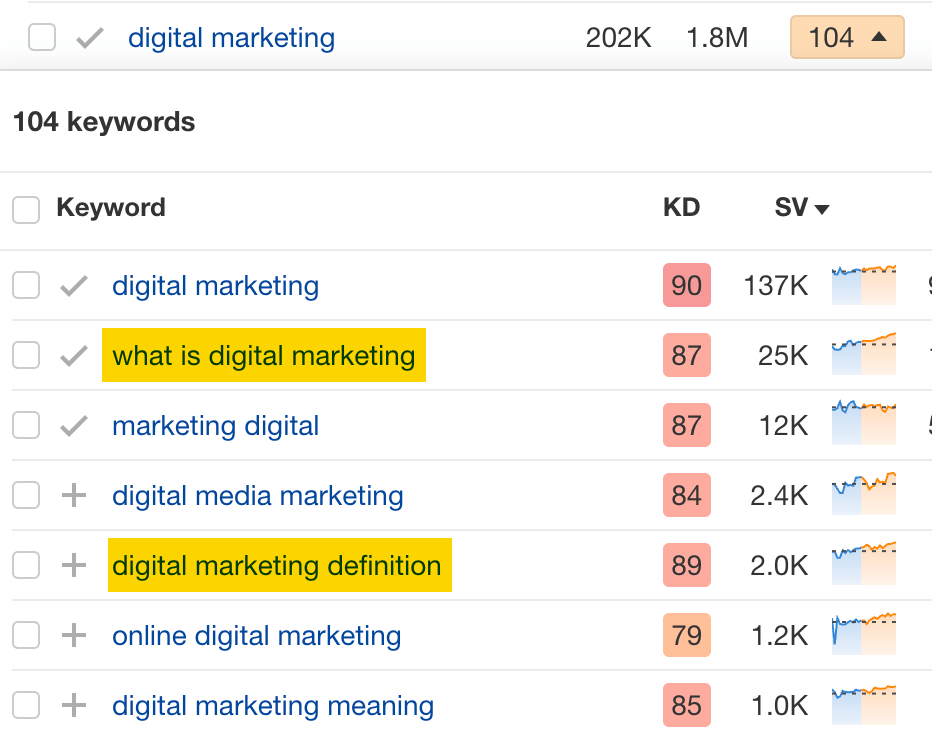

2. Optimize existing content by filling subtopics
You don’t always need to create new content to rank for competitors’ keywords. Sometimes, you can optimize the content you already have to rank for them.
How do you know which keywords you can do this for? Try this:
- Export your competitor’s keywords
- Paste them into Keywords Explorer
- Click the “Clusters by Parent Topic” tab
- Look for Parent Topics you already have content about
For example, if we analyze our competitor, we can see that seven keywords they rank for fall under the Parent Topic of “press release template.”


If we search our site, we see that we already have a page about this topic.


If we click the caret and check the keywords in the cluster, we see keywords like “press release example” and “press release format.”
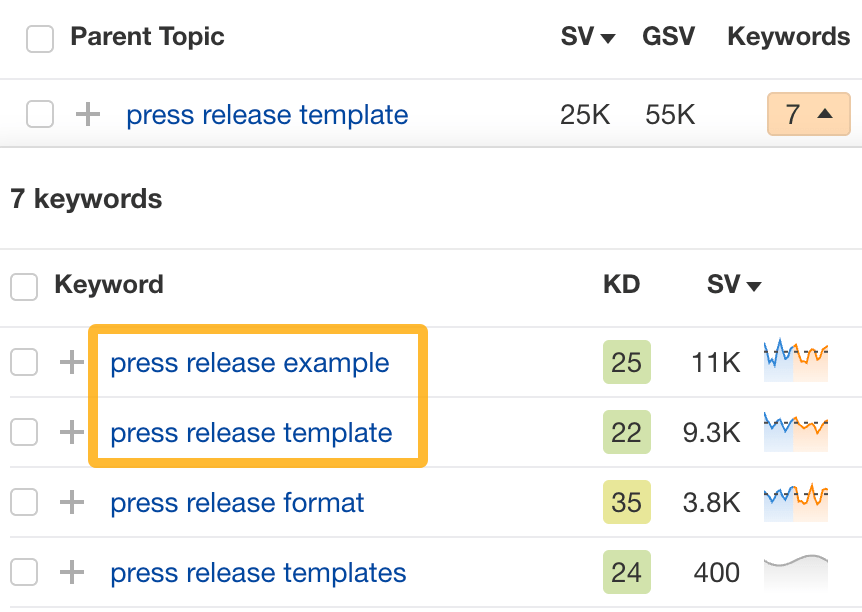

To rank for the keywords in the cluster, we can probably optimize the page we already have by adding sections about the subtopics of “press release examples” and “press release format.”
3. Target these keywords with Google Ads
Paid keywords are the simplest—look through the report and see if there are any relevant keywords you might want to target, too.
For example, Mailchimp is bidding for the keyword “how to create a newsletter.”


If you’re ConvertKit, you may also want to target this keyword since it’s relevant.
If you decide to target the same keyword via Google Ads, you can hover over the magnifying glass to see the ads your competitor is using.
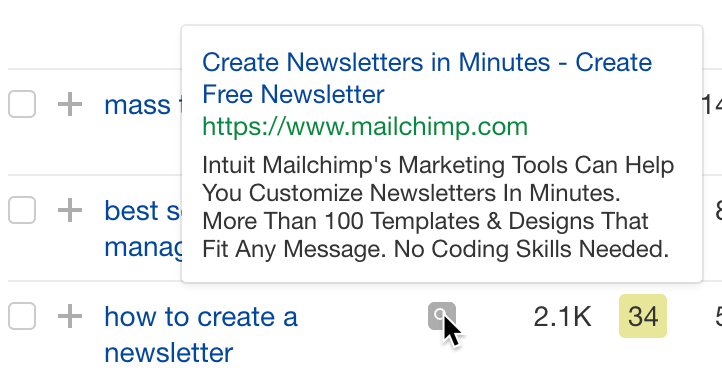

You can also see the landing page your competitor directs ad traffic to under the URL column.


Learn more
Check out more tutorials on how to do competitor keyword analysis:
-

 PPC5 days ago
PPC5 days ago19 Best SEO Tools in 2024 (For Every Use Case)
-

 MARKETING7 days ago
MARKETING7 days agoStreamlining Processes for Increased Efficiency and Results
-
SEARCHENGINES6 days ago
Daily Search Forum Recap: April 17, 2024
-

 PPC7 days ago
PPC7 days ago97 Marvelous May Content Ideas for Blog Posts, Videos, & More
-

 SEO7 days ago
SEO7 days agoAn In-Depth Guide And Best Practices For Mobile SEO
-
SEARCHENGINES5 days ago
Daily Search Forum Recap: April 18, 2024
-

 MARKETING6 days ago
MARKETING6 days agoEcommerce evolution: Blurring the lines between B2B and B2C
-
SEARCHENGINES4 days ago
Daily Search Forum Recap: April 19, 2024










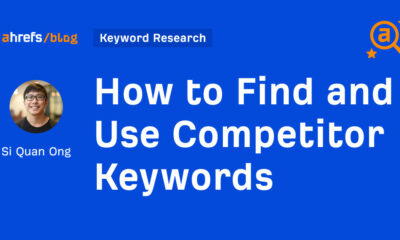

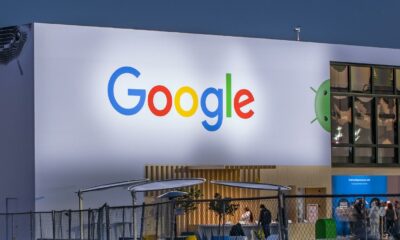



You must be logged in to post a comment Login